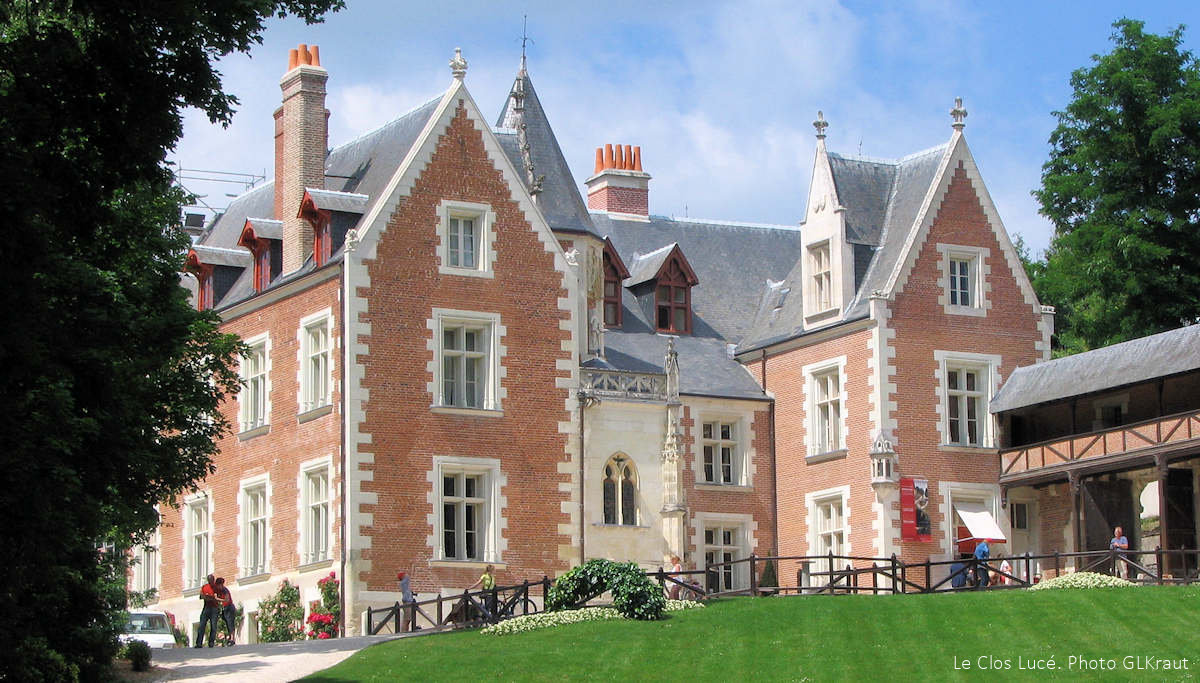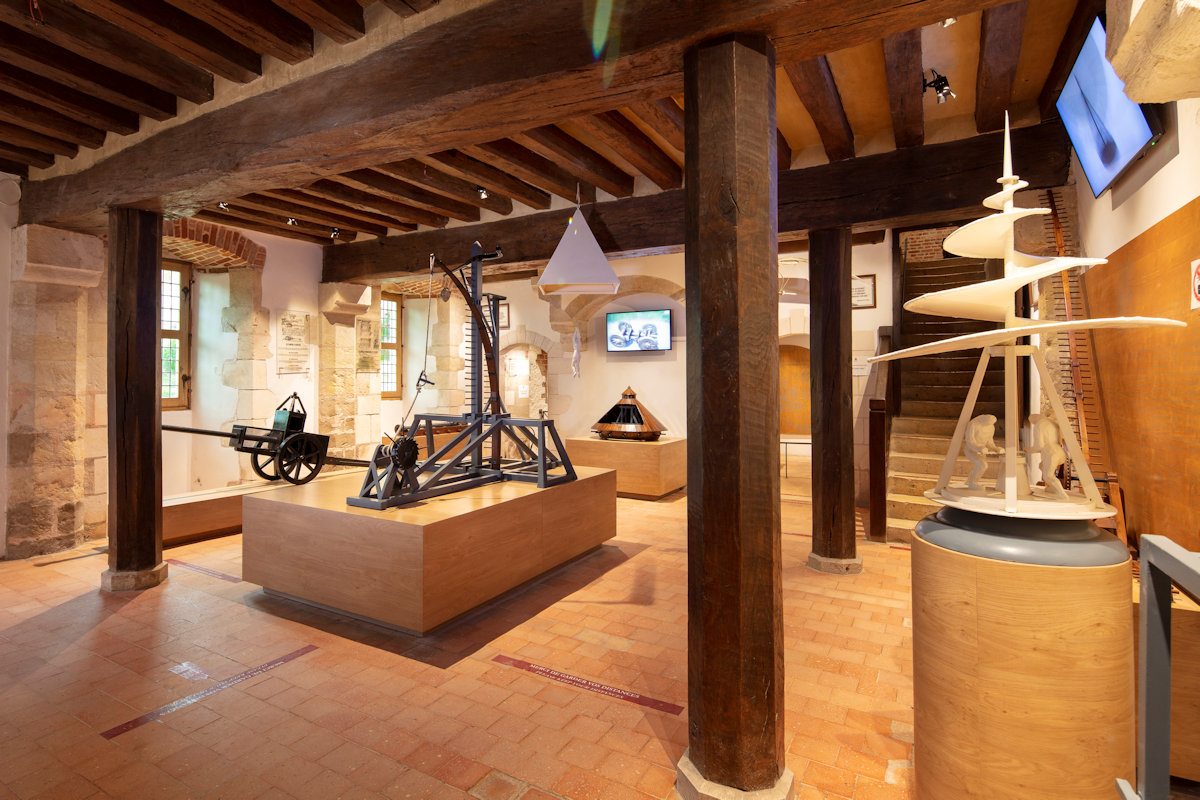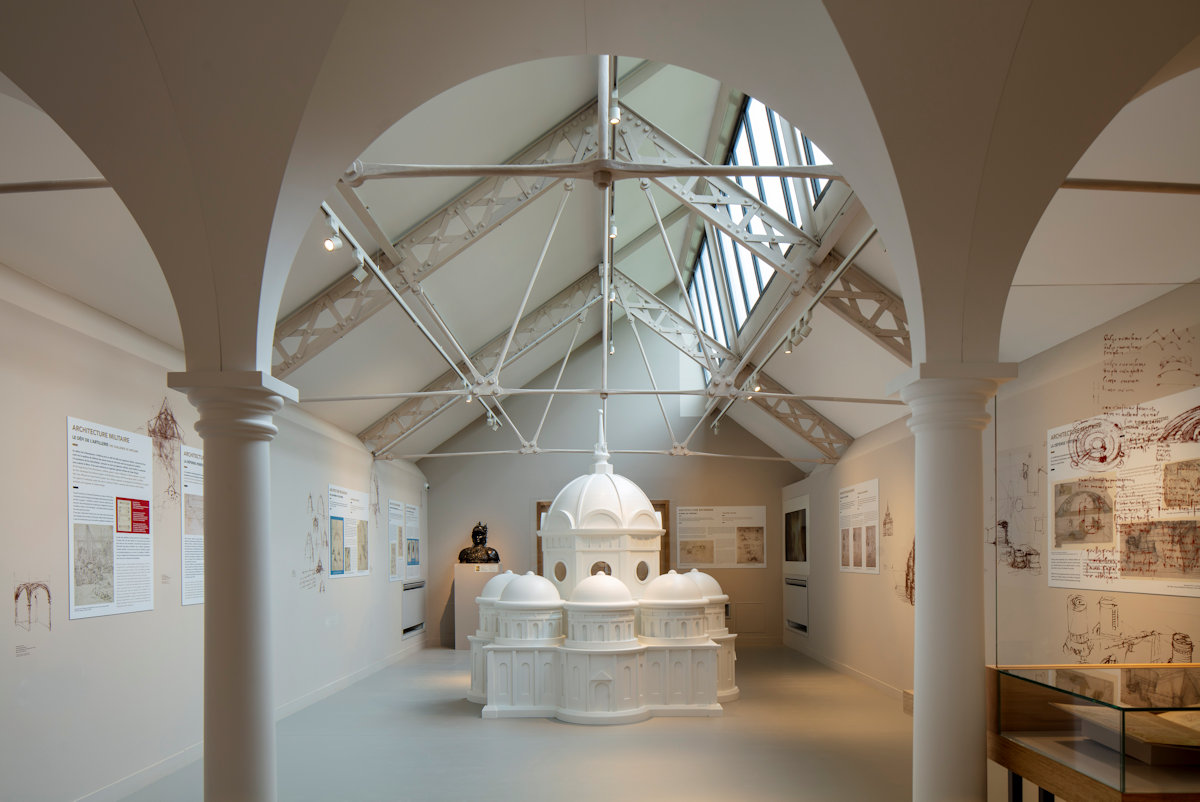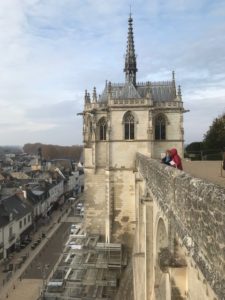
In 2021, TIME Magazine heralded 100 of the “World’s Greatest Places” to visit. The Patagonia National Park in Chile made the list, as did the Okavango Delta wildlife reserves in Botswana and the celebrated ski runs of Big Sky, Montana.
On a far more intimate scale, the Clos Lucé in Amboise, a charming brick chateau in the Loire Valley, also made the cut. Though called a chateau, the Clos Lucé more resembles a large manor, and its magic is less about royal high-rollers than the Italian commoner who resided on the grounds for three short years: Leonardo da Vinci.
With three paintings in his luggage—Mona Lisa, St. Anne and John the Baptist—Leonardo da Vinci made the long and arduous journey across the Alps to Amboise via mule-train and riverboat in 1516 at the well-paid request of King François I, his last noble patron.

While Leonardo’s French dwelling has been open to the public since the 1950s, its displays have changed and expanded over the decades, and a free-standing, immersive gallery inaugurated on the grounds in June 2021 now makes the Clos Lucé an even more enticing place the understand the genius of Leonardo (Léonard in French). It includes 21st-century high-tech gizmos that the Renaissance man himself would undoubtedly have appreciated.
The Clos Lucé is a 10-minute walk from the sprawling clifftop Château d’Amboise, that has dominated the town and the Loire River for over 800 years, where eventual King François (Francis) I grew up. Shortly after his coronation in 1515, France embarked on string of military victories on the Italian peninsula, the latest in a series of incursions there. Though they failed to secure for France the control and influence that it long sought in Italy, they did lead the king to appreciate Italian culture and to a meeting with the great Renaissance man himself. An art lover and an artist groupie, François I installed his famous Florentine guest near Amboise Castle in what was then known as the Manoir du Cloux, a 15th century turreted pink brick mansion that would later come to be called the Château du Clos Lucé. An underground passage, since filled in, linked the two properties for private king-to-genius visits.
The Cloux-cum-Clos is also associated with an earlier relationship between a royal and a commoner, that of Louis XI and a kitchen boy named Etienne Le Loup. Legend holds that one fine day in 1471 the king ventured into the royal pantry and asked the teen how much he was paid. Etienne replied “as much as the king,” leading Louis to inquire how much he thought the king earned. “As much as he needs, just like me.” The king was so charmed by this response that he gave the kid a title and the Clos Lucé holding. Etienne then expanded the manor on the site, making it much the way it appears today from the outside. Whatever the true reason for the king’s generosity, Etienne, in 1490, sold the property back to the crown, then on the head of Louis’s successor, who transformed portions of the interior (a royal chapel was added). The stage was soon sent for the property to serve as the royal guest house for da Vinci.

A Da Vinci Theme Park
Since 1855, the Clos Lucé estate has been owned by the Saint Bris family. While his parents opened the grounds to the public in 1954, it’s the current landlord, François Saint Bris, who has sprinkled the pixie dust of Leonardo’s genius throughout the property.
“Genius” is notoriously difficult to convey to a large audience. But Leonardo’s brilliance as an artist, architect, inventor, engineer and urbanist is demonstrated by actual things that can be seen, touched or used: Mona Lisa in the Louvre, the Escher-esque spiral staircase that’s primarily attributed to him at Chambord, and here at the Clos Lucé many models and visionary images to amaze and delight visitors of all ages: swiveling bridges, helicopters, automobiles, bat-winged gliders, ideal cities, urban sewage systems, theatrical spectacles and, alas, armored tanks and machine guns.
Growing up on the property, François Saint Bris wasn’t immediately drawn in by the da Vinci mystique. As a child, he says, adult discussions of “le grand Léonard” sounded like “le grand renard” (the giant fox), which was more interesting to him than “a guy called Leonard.” Clearly, he has come around as he has increasingly turned the Clos Lucé into a da Vinci theme park, with further projects on the drawing board.

The new Leonardo da Vinci Galleries form an immersive playground that recreates—though some sleight-of-hand tech from IBM, Dassault Aeronautics and the numeric architecture firm Arc-en-Scène—da Vinci’s most fantastic accomplishments. Geared to delight both children and adults, the new invention and architecture spaces, housed in a freshly renovated 19th-century factory on the property, expand on the already extensive simulations that visitors could see at the main abode of the Clos Lucé. They’re filled with 3-D models and videos, including games that simulate Leonardo’s gliders flying over the Loire, while his art is honored in a virtual and musical montage with 200 images dissolving and evolving across the walls.
And it doesn’t stop there. The extensive gardens, echoing the flowers and foliage depicted in Leonardo’s paintings, are punctuated by scale models of the inventor’s innovative bridges and computer-generated images. In the chateau/manor itself, visitors can see a reconstitution of Leonardo’s bedroom, a reconstruction of his studio, the oratory frescoes that Charles VIII commissioned for his wife Anne de Bretagne, and a life-size, walking-talking hologram of Leonardo chatting about art with the Cardinal of Aragon.

Amboise Castle and Da Vinci DNA
No “Homage to Leonardo” tour would be complete without a visit to the Château d’Amboise, in whichever order you choose to visit them. While the castle housed over a dozen kings and a plethora of dukes over the ages, it also held unwilling guests. D’Artagnan escorted the flashy financier Nicolas Fouquet of Vaux-le-Vicomte fame, to the grounds after Louis XIV accused him of embezzlement and before he was sent to a more distant and damning prison. The Emir Abd El Kader (1808-1883), leader of the Algerian resistance, was a prisoner of state at Amboise, along with his family and an entourage of 83, from 1848 until liberated by Louis Napoléon Bonaparte in 1852. There’s a statue to his memory in the castle’s park.
Inside the castle, one can see a sentimental yet historically inaccurate vision of Leonardo’s death in the arms of François I that was painted by François-Guillaume Ménageot in 1781. While the two men were indeed on very friendly terms, the king was in Saint-Germain-en-Laye when Leonardo died at the Clos Lucé.

There’s greater mystery connected with Leonardo’s final resting place. On his deathbed, the artist asked to be buried in the royal chapel in the gardens of Amboise castle, and this request was granted. However, that chapel was destroyed during the Revolution—a statue of Leonardo in the garden marks the chapel’s former location—but at the time no one was overly concerned with the graves on the site.
Leonardo’s lily-bedecked tomb was moved to another chapel at the castle site, Chapelle de Saint Hubert, a small, freestanding Flamboyant Gothic edifice, decorated with antlers because Hubert is the patron saint of hunters.
But is Leonardo da Vinci really buried there?
It wasn’t until 1863, when historian Arsène Houssaye started poking through the debris, that a coffin and some coins minted during François I’s reign were discovered and nearby remains were designated as da Vinci’s.
This has engendered countless, Dan Brownish discussions over the years along on the lines of “was the body now entombed in the current Amboise grave left-handed like Leonardo?” Advances in DNA research—and the da Vincimania that accompanied the 500-year commemorations of his death in 2019 (when the Clos Lucé drew a record 520,000 visitors)—sparked an international fire-storm of interest in the genetic heritage of the remains in the tomb.
Leonardo’s DNA has proved elusive. He apparently had no direct offspring yet his extremely prolific father, a Florentine notary, spawned double-digit half-siblings for the artist. Samples from the remains in the Amboise vault have been sent to several DNA labs, but there’s been no definitive answer as yet. For the moment, Leonardo’s chromosomes are still as enigmatic as Mona Lisa’s smile.
Practical information
Though more likely visited during extended explorations in the Loire Valley, Amboise can be the object of a carefully-timed day trip from Paris. Trains from Paris’s Austerlitz and Montparnasse stations take between an hour and a half and two hours. The Clos Lucé and the Château d’Amboise are just over a mile from the train station. A shuttle bus links the train station with the center of town.
Parking for cars and bicycles is also available in proximity of those sights. There are three public parking lots in Amboise within walking distance of the chateau, along with a designated Clos Lucé lot.
There are two restaurants on the Clos Lucé grounds: La Terrasse Renaissance (salads and crepes) and La Table du Moulin (grilled meat, salads and take-away sandwiches), to be enjoyed on shaded picnic tables. A third restaurant, L’Auberge du Prieuré, specializing in Renaissance-style fare and wines spiked with herbs and honey, is open for groups of 15 or more, reservations required. Picnics are also permitted on the grounds of the Château d’Amboise, which has an on-site café. There are also many cafés and eateries in the stroll-worthy town Amboise, though the primary points of interest are the castle and the Clos Lucé.
Château du Clos-Lucé – Parc Leonardo da Vinci, 2 rue du Clos Lucé, Amboise. Closed December 25 and January 1.
Château d’Amboise/Amboise Castle, Montée de l’Emir Abd El Kader, Amboise. Closed December 25 and January 1.
© 2022, Corinne LaBalme


Brilliant!!!!